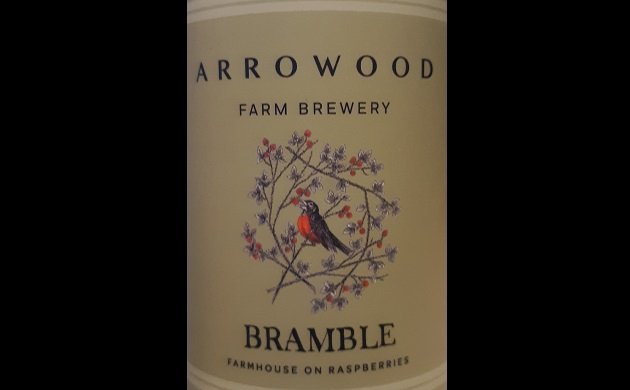
WELCOME, welcome, little stranger,
Fear no harm, and fear no danger;
We are glad to see you here,
For you sing “Sweet Spring is near.”
Now the white snow melts away;
Now the flowers blossom gay:
Come dear bird and build your nest,
For we love our robin best.
“To the First Robin” by Louisa May Alcott (1832-1888)
Louisa May Alcott’s short poem “To the First Robin” is just one of many artistic works that celebrate the American Robin (Turdus migratorius) as a hopeful portent of spring’s return. As every schoolchild knows, the sight of that first robin bounding across the front lawn, perhaps still dotted with holdout clumps of melting snow, is a sign the long-awaited end of winter isn’t too far off. This cheerful, red-breasted thrush almost seems to be pulling a new season out of thawing earth with each forceful tug on the stubborn earthworms it devours with obvious delight, following its own long winter of foraging for shriveled crabapples and hard, frozen berries.
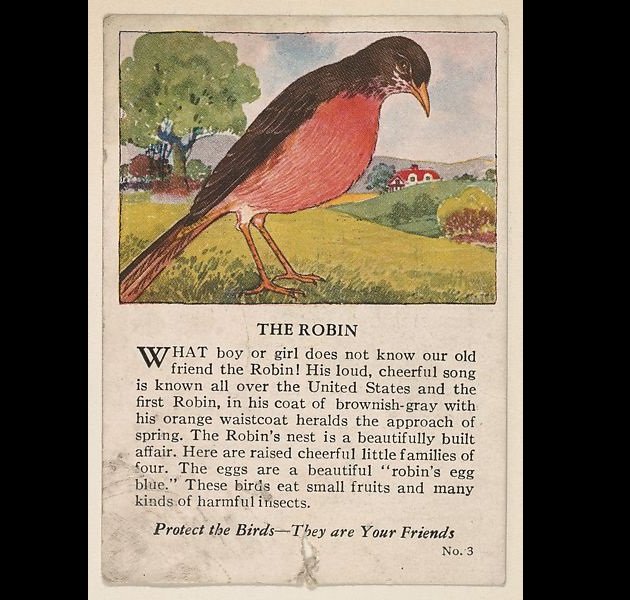
The Robin, No. 3, collector card from the Bird Cards series (D16), issued by the White Baking Company, St. Louis, Missouri (early 20th century). From the collection of the Metropolitan Museum of Art, New York.
Of course, it’s tricky for birders to reconcile popular associations about robins and spring with our own observations: over much of North America, most of us will get our first glimpse of a robin for the year on a first day walk on New Year’s Day, or at least within a few days after that. Still, it’s hard not to get caught up with the excitement of the changing seasons in late March, especially as the weather warms and the jolly, sweetly rolling song of the robin goes from being an occasional and somewhat odd midwinter occurrence to daily performances that greet a world about to burst into bloom.
Today is the first full day of spring, with the vernal equinox sneaking in just before midnight yesterday in my part of the world. And while the robin is undoubtedly quite happy with its springtime feast of worms, here at Birds and Booze, we can celebrate the changing season with more appetizing ingredients – including one at which a robin certainly wouldn’t turn up its beak at other times of the year: the raspberry.
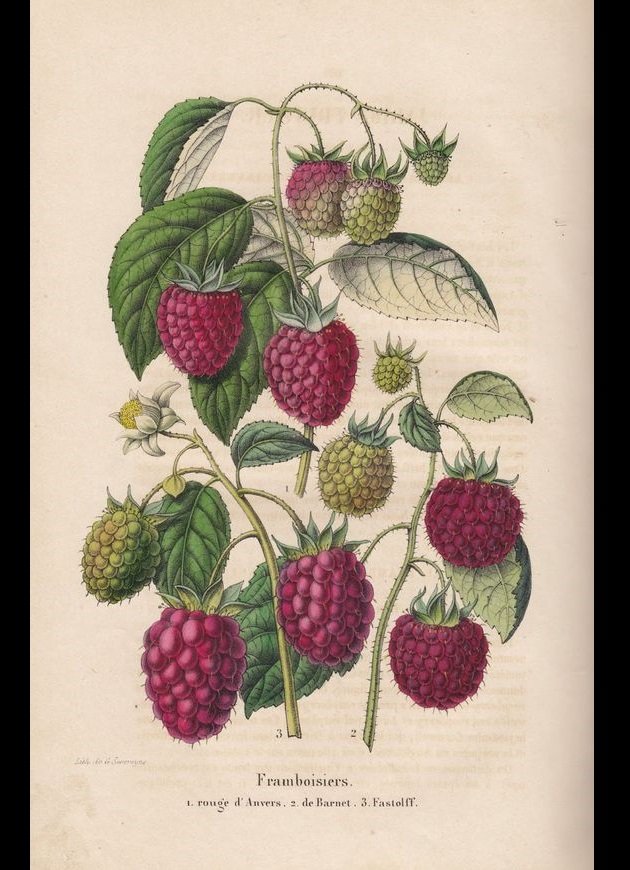
Various raspberry varieties depicted in a vintage botanical illustration.
Our featured beer this week is Bramble, a dry-hopped farmhouse ale from the Arrowood Farm Brewery of Accord, New York, made with – as the name suggests – raspberries. We’re at least another quarter of a year from peak raspberry season in the summer, but unlike the robin, we needn’t wait for fresh, ripe berries in July to enjoy their tart, luscious flavor. Thanks to the miracle of fermentation, these flavors can be preserved in beer all year round, as is the custom in Belgium. There, raspberry beer – called framboise from the French word for the fruit – is a venerable part of the brewing tradition, and every summer, bushels of berries are loaded into barrels of aging ale – provided enough of the crop can be saved from the birds, that is. And that’s no mean feat no matter where they’re grown, as it happens.

The charming can art for Bramble was done by Woodstock, New York artist Will Lytle, working under the name Thorneater.
Writing in The Wilson Bulletin (the quarterly journal of The Wilson Ornithological Society) in March 1933, amateur naturalist Grant Henderson recounts his struggles in defending his own modest raspberry patch in Greensburg, Indiana from a family of American Robins in an article titled Robins and Raspberries:
And how the parents did gorge those young Robins with raspberries the moment they were ripe. The old birds, together with the four young from the first nest, literally lived in the patch. […] I did grow a bit warm under the collar when they insisted on devouring every ripe raspberry on the place. I believe that those eleven Robins got a fourth of the crop.
Frustrated as he was, Henderson refrained from retaliating too drastically:
Loving almost all birds too well to destroy them, I tried a dozen different methods in an attempt to frighten them from the patch. But did I succeed? No! They were bold enough to help themselves to berries on vines but a few feet from me when I would be picking. Once, as the female adult Robin sat on one of the stakes to which the plants are tied, not more than ten feet from me, I snatched off a green berry and tossed it at her, taking her fairly alongside the head. She gave a saucy “kee-elp” and dived into a clump of raspberries and, appearing a moment later with a ripe berry, she winged her way towards the nest in the hard maple.
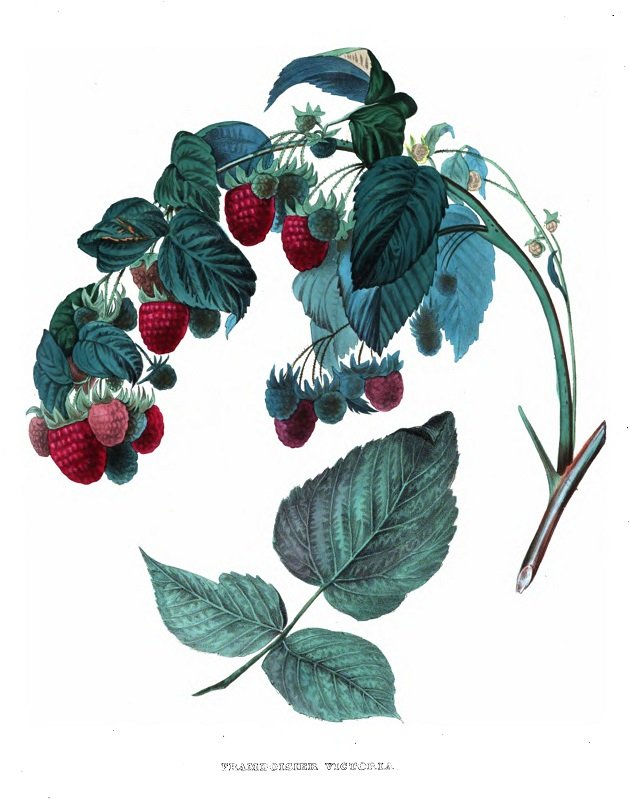
Raspberries from the Annales de pomologie belge et étrangère, first published in Brussels in 1853.
According to Henderson, the robins were discerning customers, too, sampling each berry one nibble at a time, and in the end, choosing only the most delicious ones to devour completely:
They were as painstaking at times as a connoisseur examining a work of art. Damaged berries left in the patch were proof of the fact that the birds were critical when it came to the sense of taste. I usually refrained from picking until the dew was off the berries, but the Robins did not wait, and when I appeared they had, as a rule, retired for the day, leaving me a few ripe and near-ripe berries, and not a few mutilated ones. I have often wondered if the young Robins ever had a change of diet while the raspberry season lasted. I doubt it.
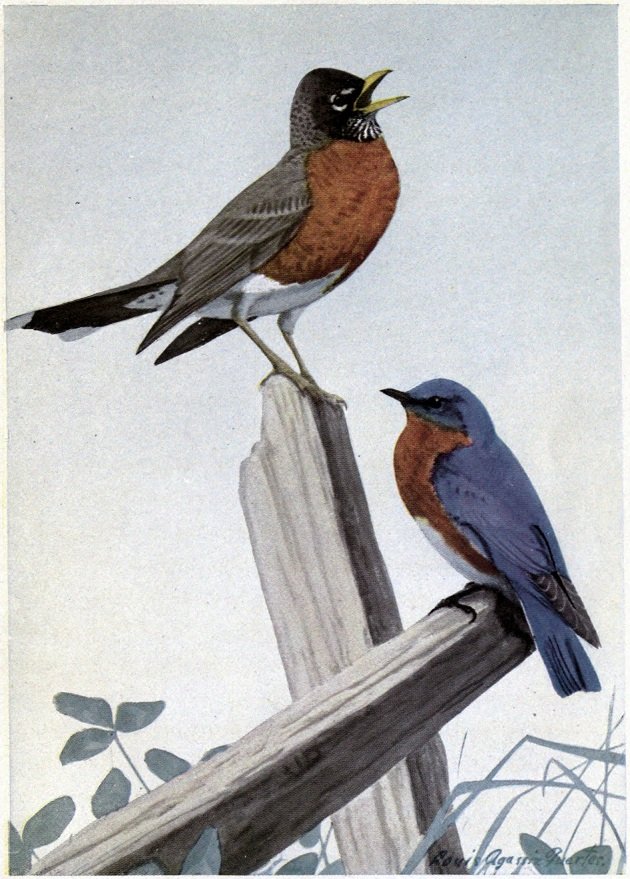
“WELCOME ROBIN. No other bird has a russet breast like his.
WINSOME BLUEBIRD. His blue back, wings and tail leave no doubt as to who he is.”
Illustration by Louis Agassiz Fuertes (1874-1927) of an American Robin and an Eastern Bluebird (Sialia sialis) from The Burgess Bird Book for Children (1919).
Considering all that, it’s no small miracle that Arrowood Farm Brewery was able to spare enough local raspberries from the insatiable appetites of birds to make Bramble. The fruit was handpicked at Arrowood’s Hudson Valley neighbor Kelder’s Farm, who also supplied the malt for this beer. Hops are of the Mackinac variety, a proprietary cultivar developed in 2014 by Great Lakes Hops of Zeeland, Michigan, but grown more locally for Bramble in New York’s Finger Lakes region.
It’s evident that enough raspberries went into Bramble to give it the one of the prettiest colors one could hope for in a beer – or any tipple, for that matter: a shimmering, orange-tinted shade of rose that recalls the ripe flesh of a Ruby Red grapefruit. Nor is there any lack of the fruit in Bramble’s aroma: there’s a fragrant measure of ripe, almost floral raspberry in the bouquet, supported by a distinctly limey sourness, a fresh hint of green melon, and a complex herbal note of rosemary. The palate is tart and refreshing, with concentrated flavors of red berry preserves and a touch of rosewater, marrying Bramble’s fruity, mellow sourness to a lightly malty background. The finish is mouthwatering and citrusy, with a zippy shot of raspberry running through to the very end.
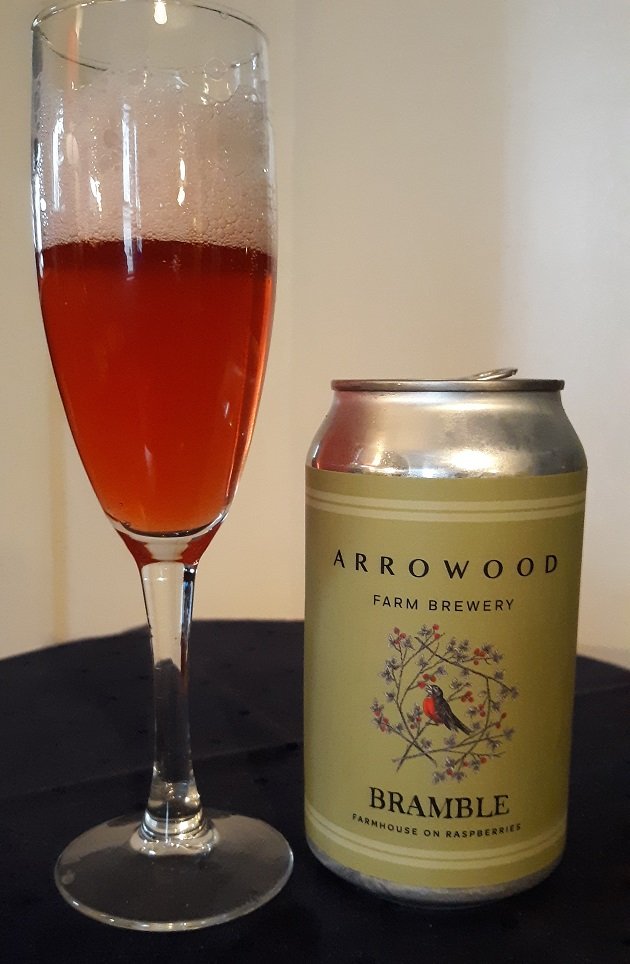
It’s only March, of course, and there won’t be any brambles of raspberries ripe enough for eating – either by people or by birds – for a few more months. But there’s enough fantastic raspberry flavor packed into Arrowood’s Bramble to tide us over until the peak of the summer berry season — and lucky for us, we don’t have to share this fruit with the robins. I like to think they’ll be busy enough with the worms in our yards for a while, anyway.
Good birding and happy drinking — and happy Spring!
Arrowood Farm Brewery: Bramble Farmhouse on Raspberries
![]()
![]()
![]()
![]()
![]()
Four out of five feathers (Excellent).













Beautiful post about robins and spring 🙂
Thank you – and thanks for reading!